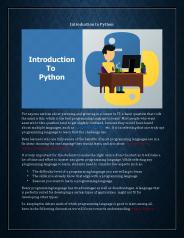Introduction to Classes and OO Programming. - PowerPoint PPT Presentation
1 / 20
Title:
Introduction to Classes and OO Programming.
Description:
One major problem with the work covered so far is that we have created programs ... of the company are often drifting into a soporific state and falling asleep. ... – PowerPoint PPT presentation
Number of Views:35
Avg rating:3.0/5.0
Title: Introduction to Classes and OO Programming.
1
Introduction to Classes and OO Programming.
2
- One major problem with the work covered so far is
that we have created programs based solely on a
single form. - When programming real systems in VB.NET your
project is seldom limited to a single form. - Many programs have a number of forms (components)
and these forms need to be managed in a sensible
way.
3
Hire Car System.
- May involve the following forms
- Password Screen.
- Main Menu.
- Customer Details Form.
- Booking Form.
4
Issues to Consider with Multiple Forms.
- 1. Problems with code duplication.
- We dont want sections of code repeated.
- 2. Problems with code re-use.
- We want to be able to recycle our code.
5
Consider A Search Facility.
- Imagine you had a form in your system which
allows you to search for cars, e.g. those that
are free for hire on a specific date, those that
are of a certain make etc. This form is used to
make bookings for customers.
6
Search Facility Version 1
- Search button on a form.
- Code exists within a Sub Procedure within the
form.
7
Search Facility Version 2
- Search for cars that are in need of
servicing/various states of damage.
8
Code Duplication.
- The first problem we have created here is
potential for code duplication. - By having a search facility in both forms we have
two sections of search code which are going to be
pretty similar.
9
A Solution?
- One solution might be to only place the search
code behind one of the forms and then somehow
call the search from one form to another. - Q. Is this an acceptable solution?
- We have solved the problem of duplication but are
now faced with a few other problems. - Firstly to call the code in one form from another
we need to have both forms open, when all that we
want is the facility to search.
10
Q. So how do we solve this problem?
- A. We introduce the idea of a Class Module.
11
Features of a Class.
- Two main features of a class are methods and
properties. - Methods (Sometimes referred to as Operations.)
e.g. DoSearch. - Properties (Sometimes referred to as Attributes)
e.g. Count.
12
Methods and Properties You have Used Already!
- Methods.
- lstStudents.Items.Add
- lstStudents.Items.RemoveAt
- MessageBox.Show("Hello World")
- Properties.
- txtInput.Text
- btnDelete.Enabled
13
The Reminder Application.
- For the next four weeks we shall be building a
small but useable multi form application called
Reminders. - The program allows the user to set timed
reminders (alarms) which will "go off" at
specified points in time. - In a moment we shall look at the finished program.
14
The Universal Modelling Language Documentation.
- In addition to the program you have been provided
with a set of documentation using the Universal
Modelling Language, (UML). - UML is a set of documents that may be used to
plan design and document object oriented (OO)
programs like the Reminder application. - Some of you have seen UML documentation in your
Systems Analysis and Design Module.
15
Instantiation Classes v Objects.
- When you create a class, you are creating a
template from which you make your objects. - For example in Word you have a set of templates
for such things as letters and memos. When you
create a new letter, you take a copy of the
template and make an actual instance of a letter.
16
Encapsulation Public v Private.
- One important feature of using classes is that we
really don't care how they work. - For example to add an item to a list box we might
use the following line of code - lstMyList.Items.Add("Hello")
- The Add method is all we are interested in, we
don't care how it adds the word "Hello" to the
list just that it will do it.
17
Project Description GNiteall plc
- GNiteall is a company specialising in the
manufacture of aromatic oils to assist with
insomnia. Unfortunately due to the effectiveness
of their products and continued exposure, the
employees of the company are often drifting into
a soporific state and falling asleep. - The management wish to address this problem by
ensuring that each employee has installed on
their computer a reminder system which will alert
staff of important appointments (which they are
often missing). - The initial stages of the project will allow the
user to add, edit and delete timed reminders that
will activate at the appropriate time and alert
the user. A later revision of the program will
add sound thus waking the user, but at this stage
a basic implementation is proposed.
18
Use Case Diagram.
19
Use Case Description.
- Reminder Management
- The user adds a new reminder to the reminder
list. - The user edits an existing reminder in the
reminder list. - The user deletes a reminder in the reminder list.
- The user opens a reminder list.
- The user closes a reminder list.
- The user snoozes a reminder by 10 minutes.
- The timer triggers an active reminder.
20
Class Diagram.































